The Picos de Europa are a range of limestone mountains in Northern Spain, rising to about 8500ft, and a couple of hundred miles west of the Pyrennes.
Saturday.
We travelled by train to Stansted via London, flew to Bilbao and drove a hire car for about 2.5 hours to our hotel for the first 3 nights, in the hills near the small town of Potes. We arrived around midnight.
Sunday.
As breakfast wasn't until 9am (typically Spanish), we went for a stroll down the road from the hotel before it. A
Black Redstart was soon found, and a couple of hundred yards further on a male
Cirl Bunting showed well
. A loud but distant call from the valley bottom was almost certainly a
Wryneck, but although we heard it several times in the next few days, we never saw it.
After breakfast, we drove the few miles into Potes for provisions, as a few
Crag Martins flew overhead. A Red Squirrel scurried across the road in front of us.
As the weather was cool and drizzly, we decided to drive for a while. At one small village, another showy
Black Redstart flitted around, and as we watched, a flock of
Serin landed in a
tree behind it
. We reached the small town of Raina as it brightened slightly, and stopped to scan a large reservoir there. There was little on there, the highlight being a
Yellow Legged Gull. A couple of stork's nests were empty, unfortunately. A distant dot over the mountains grew rapidly into a huge raptor, my first
Griffon Vulture. Soon there were seven of them, and they drifted fairly low over us, excellent.
We stopped several times on the way back, but mainly only found familiar species. A
Black Kite was sat in a field, but there was nowhere to stop and watch it properly.
I went for another stroll from the hotel early evening, and found at least three more
Cirl Buntings.



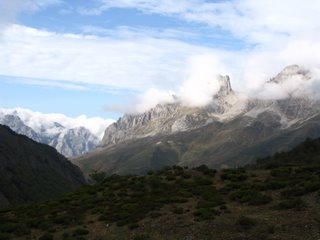
Monday. A brighter day, with some clouds over the high mountains.
We decided to do a circular walk from the hotel, and soon were in woods.
Crested Tits were heard, but couldn't be found.
Out in the open, we soon started finding butterflies:
Clouded Yellows were very common, several
Adonis Blues, our first
Brown Hairstreaks, a
Lesser Purple Emperor, Mazarine Blues, and lots of
Long Tailed Blues, amongst more familiar species including hundreds of
Wall and
Grayling.
A
Booted Eagle drifted over, and
Griffon Vultures were usually visible above nearby high mountains, drifting in and out of clouds.


Tuesday. Hot and sunny.
Whilst having breakfast on the terrace, more
Serins were buzzing around, but they were soon ignored when a bird flew into one the closest trees to us. It was a male
Middle Spotted Woodpecker, and it's mate was soon found a little further away.
We drove to a nearby valley, parked near the village at the end of the road, and prepared to walk into the mountains. As we were putting our boots on, a
Short Toed Eagle showed well over a nearby wood. In the village, an old lady insisted on giving us apricots from her apron full of them. Although we ate some during the walk, we still had 36 of them left when we finished!
We passed
Pied Flycatchers and a
Marsh Tit, as well as
Crag Martins, and the enevitable
Black Redstarts.
Large brown lizards basked on rocks, and small green ones shot off before a camera could be aimed at them.
Higher up, we were rewarded with a stunning view, and 18
Griffon Vultures together. Keep moving, or they'll think you're a snack!
A pair of
Rock Buntings showed well, and a few others were seen later on. A
Large Wall Brown had us puzzled for a while, and a
Meadow Fritillary posed nicely. A long dusty walk was livened by crickets that we flushed every few yards. Some showed pink in flight, and some showed bright blue. Nice!
We were nearly back at the car when Gill found a Praying Mantis, green and stunning. I found a brown one, looking just like a clothes peg!
We then had a short drive to our self catering apartment, where we stayed for the rest of the week, eating mainly apricots....

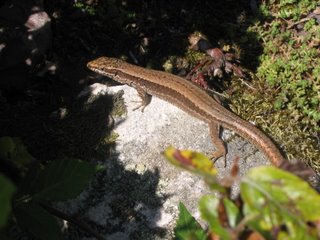

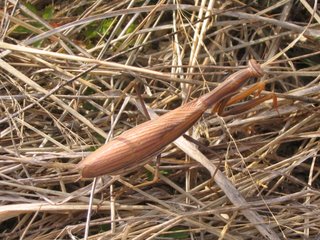
Wednesday.
The forecast was for a hot sunny day, with light winds, so we headed for Alpine habitat.
An hour's drive brought us to the car park for the Fuente De cable car, which climbs 2400ft to approx 5500ft in less than 4 minutes, saving hours of hard walking. We were advised to be there early, to avoid queuing for the cable car.
Whilst we waited, a flock of
Red Billed Choughs fed in a field,
Griffon Vultures perched on the rocks high above,
Rock Buntings and
White Wagtails were on grass outside a hotel.
We took the first cable car at 10am, and within a few minutes of leaving the station, a pair of
Alpine Choughs flew past. Gill saw a small bird in flight, so we looked for it, as anything that high up was likely to be interesting. It was an
Alpine Accentor. Soon, however, a party of loud Spaniards approached, and flushed it.....
Water Pipits were numerous up here, as were
Black Redstarts, and
Linnets. However, we had information about a far rarer and elusive species that was sometimes seen about 20 mins walk away.
A couple from Norfolk walked with us, as they were also looking for the same species. We soon reached the cliff face that we expected to scan for hours, and looked for comfortable boulders to sit on for our vigil. Before we had chance to sit, Gill saw a small bird flitting between the boulders below us. A couple of minutes later, it popped up, and gave myself and the gentleman from Norfolk good, but brief views, of a
Wallcreeper! Yes!
Unfortunately, the ladies missed it, so we waited another hour, and gradually the bird approached us, until it was within 25 feet of us. We all had good binocular views (the scope was in the car, as a long walk awaited us). Eventually, it flew a long way down the slope, and we said goodbye to the Norfolk birders.
We began to gradually descend, pausing to admire a couple of small groups of "
Spanish"
Yellow Wagtails. We stopped for lunch at a refuge (more like a hotel and bar) at 4500 feet.
A pair of
Alpine Choughs hung around, and as soon as we left our picnic table, they lived up to my families nickname for them of "Picnic Crows", by investigating our table for crumbs.
Shortly afterwards, a small raptor flew past, and a brief view proved it to be a stunning male
Lesser Kestrel.
No new birds or butterflies were seen lower down, but several hours later, as we approached the car park, a
Firecrest sang briefly from some tall conifers.
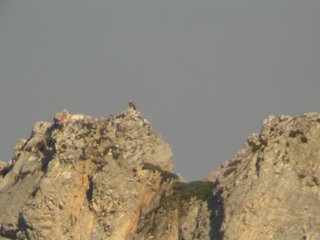
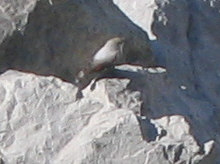


Thursday. Warm and very windy in the morning, turning to rain in the afternoon.
We had a gentle drive to nearby valleys, not seeing anything new, before the rain began. As we were both quite tired and aching after last previous days exploits, we were not too disappointed.
Friday. Much brighter.
A long, twisty drive took us to the Cares Gorge, for an interesting walk. The Gorge makes Cheddar Gorge look like a crease in a tablecloth! As we put boots on, a pair of
Golden Eagles soared over the cliffs.
We stopped for lunch by a bridge over the river, and Gill had a quick look down, and immediately found...a
Wallcreeper.
We watched it for at least 45mins, and a steady stream of walkers of various nationalities passed, and only a few asked what we were watching. A few wobbly digi-binned video clips of it were obtained. A
Lesser Kestrel called, and soon gave brief views.
The scenery was amazing, and we walked for a fair way along, before turning to retrace our steps. Soon I found another
Wallcreeper, very close, and again, below us!
The drive back produced more
Rock Buntings, a group on the road!


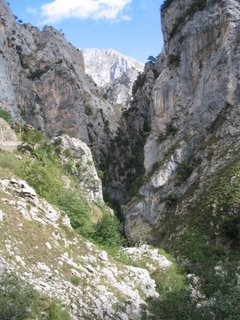

Saturday. Bright.
We began the drive back to Bilbao, where we were to spend our last night in Spain.
Flocks of birds flying over were presumed to be
Spotless Starlings, as they are the common ones there, but decent views were not possible.
We stopped off at an estuary between Santander and Bilbao, and soon found about 8
Black Necked Grebes. A few
Whimbrel were amongst more common waders. A small pool over the road revealed only some familiar ducks, but the field beyond it was more profitable, with a flock of approx 30
Cattle Egrets.
67 species of
birds seen during the week (8 or 9 "lifers" depending on the "starling sp", 8 more heard, and 18 species of
butterfly (6 "lifers")
.
In Bilbao, Gill dragged me along to the Guggenheim museum, bereft of wildlife, except for a
Black Kite drifting over, oh, and a strange dog outside the museum........


Sunday.
An uneventful journey home, the highlight being a couple of pints of excellent
Fuller's Hock at Paddington Station, and proper British food-
Chicken Tikka Masala!



 Monday. A brighter day, with some clouds over the high mountains.
We decided to do a circular walk from the hotel, and soon were in woods. Crested Tits were heard, but couldn't be found. Out in the open, we soon started finding butterflies: Clouded Yellows were very common, several Adonis Blues, our first Brown Hairstreaks, a Lesser Purple Emperor, Mazarine Blues, and lots of Long Tailed Blues, amongst more familiar species including hundreds of Wall and Grayling.
A Booted Eagle drifted over, and Griffon Vultures were usually visible above nearby high mountains, drifting in and out of clouds.
Monday. A brighter day, with some clouds over the high mountains.
We decided to do a circular walk from the hotel, and soon were in woods. Crested Tits were heard, but couldn't be found. Out in the open, we soon started finding butterflies: Clouded Yellows were very common, several Adonis Blues, our first Brown Hairstreaks, a Lesser Purple Emperor, Mazarine Blues, and lots of Long Tailed Blues, amongst more familiar species including hundreds of Wall and Grayling.
A Booted Eagle drifted over, and Griffon Vultures were usually visible above nearby high mountains, drifting in and out of clouds.

 Tuesday. Hot and sunny.
Whilst having breakfast on the terrace, more Serins were buzzing around, but they were soon ignored when a bird flew into one the closest trees to us. It was a male Middle Spotted Woodpecker, and it's mate was soon found a little further away.
We drove to a nearby valley, parked near the village at the end of the road, and prepared to walk into the mountains. As we were putting our boots on, a Short Toed Eagle showed well over a nearby wood. In the village, an old lady insisted on giving us apricots from her apron full of them. Although we ate some during the walk, we still had 36 of them left when we finished!
We passed Pied Flycatchers and a Marsh Tit, as well as Crag Martins, and the enevitable Black Redstarts.
Large brown lizards basked on rocks, and small green ones shot off before a camera could be aimed at them.
Higher up, we were rewarded with a stunning view, and 18 Griffon Vultures together. Keep moving, or they'll think you're a snack!
A pair of Rock Buntings showed well, and a few others were seen later on. A Large Wall Brown had us puzzled for a while, and a Meadow Fritillary posed nicely. A long dusty walk was livened by crickets that we flushed every few yards. Some showed pink in flight, and some showed bright blue. Nice!
We were nearly back at the car when Gill found a Praying Mantis, green and stunning. I found a brown one, looking just like a clothes peg!
We then had a short drive to our self catering apartment, where we stayed for the rest of the week, eating mainly apricots....
Tuesday. Hot and sunny.
Whilst having breakfast on the terrace, more Serins were buzzing around, but they were soon ignored when a bird flew into one the closest trees to us. It was a male Middle Spotted Woodpecker, and it's mate was soon found a little further away.
We drove to a nearby valley, parked near the village at the end of the road, and prepared to walk into the mountains. As we were putting our boots on, a Short Toed Eagle showed well over a nearby wood. In the village, an old lady insisted on giving us apricots from her apron full of them. Although we ate some during the walk, we still had 36 of them left when we finished!
We passed Pied Flycatchers and a Marsh Tit, as well as Crag Martins, and the enevitable Black Redstarts.
Large brown lizards basked on rocks, and small green ones shot off before a camera could be aimed at them.
Higher up, we were rewarded with a stunning view, and 18 Griffon Vultures together. Keep moving, or they'll think you're a snack!
A pair of Rock Buntings showed well, and a few others were seen later on. A Large Wall Brown had us puzzled for a while, and a Meadow Fritillary posed nicely. A long dusty walk was livened by crickets that we flushed every few yards. Some showed pink in flight, and some showed bright blue. Nice!
We were nearly back at the car when Gill found a Praying Mantis, green and stunning. I found a brown one, looking just like a clothes peg!
We then had a short drive to our self catering apartment, where we stayed for the rest of the week, eating mainly apricots....



 Wednesday.
The forecast was for a hot sunny day, with light winds, so we headed for Alpine habitat.
An hour's drive brought us to the car park for the Fuente De cable car, which climbs 2400ft to approx 5500ft in less than 4 minutes, saving hours of hard walking. We were advised to be there early, to avoid queuing for the cable car.
Whilst we waited, a flock of Red Billed Choughs fed in a field, Griffon Vultures perched on the rocks high above, Rock Buntings and White Wagtails were on grass outside a hotel.
We took the first cable car at 10am, and within a few minutes of leaving the station, a pair of Alpine Choughs flew past. Gill saw a small bird in flight, so we looked for it, as anything that high up was likely to be interesting. It was an Alpine Accentor. Soon, however, a party of loud Spaniards approached, and flushed it.....
Water Pipits were numerous up here, as were Black Redstarts, and Linnets. However, we had information about a far rarer and elusive species that was sometimes seen about 20 mins walk away.
A couple from Norfolk walked with us, as they were also looking for the same species. We soon reached the cliff face that we expected to scan for hours, and looked for comfortable boulders to sit on for our vigil. Before we had chance to sit, Gill saw a small bird flitting between the boulders below us. A couple of minutes later, it popped up, and gave myself and the gentleman from Norfolk good, but brief views, of a Wallcreeper! Yes!
Unfortunately, the ladies missed it, so we waited another hour, and gradually the bird approached us, until it was within 25 feet of us. We all had good binocular views (the scope was in the car, as a long walk awaited us). Eventually, it flew a long way down the slope, and we said goodbye to the Norfolk birders.
We began to gradually descend, pausing to admire a couple of small groups of "Spanish" Yellow Wagtails. We stopped for lunch at a refuge (more like a hotel and bar) at 4500 feet.
A pair of Alpine Choughs hung around, and as soon as we left our picnic table, they lived up to my families nickname for them of "Picnic Crows", by investigating our table for crumbs.
Shortly afterwards, a small raptor flew past, and a brief view proved it to be a stunning male Lesser Kestrel.
No new birds or butterflies were seen lower down, but several hours later, as we approached the car park, a Firecrest sang briefly from some tall conifers.
Wednesday.
The forecast was for a hot sunny day, with light winds, so we headed for Alpine habitat.
An hour's drive brought us to the car park for the Fuente De cable car, which climbs 2400ft to approx 5500ft in less than 4 minutes, saving hours of hard walking. We were advised to be there early, to avoid queuing for the cable car.
Whilst we waited, a flock of Red Billed Choughs fed in a field, Griffon Vultures perched on the rocks high above, Rock Buntings and White Wagtails were on grass outside a hotel.
We took the first cable car at 10am, and within a few minutes of leaving the station, a pair of Alpine Choughs flew past. Gill saw a small bird in flight, so we looked for it, as anything that high up was likely to be interesting. It was an Alpine Accentor. Soon, however, a party of loud Spaniards approached, and flushed it.....
Water Pipits were numerous up here, as were Black Redstarts, and Linnets. However, we had information about a far rarer and elusive species that was sometimes seen about 20 mins walk away.
A couple from Norfolk walked with us, as they were also looking for the same species. We soon reached the cliff face that we expected to scan for hours, and looked for comfortable boulders to sit on for our vigil. Before we had chance to sit, Gill saw a small bird flitting between the boulders below us. A couple of minutes later, it popped up, and gave myself and the gentleman from Norfolk good, but brief views, of a Wallcreeper! Yes!
Unfortunately, the ladies missed it, so we waited another hour, and gradually the bird approached us, until it was within 25 feet of us. We all had good binocular views (the scope was in the car, as a long walk awaited us). Eventually, it flew a long way down the slope, and we said goodbye to the Norfolk birders.
We began to gradually descend, pausing to admire a couple of small groups of "Spanish" Yellow Wagtails. We stopped for lunch at a refuge (more like a hotel and bar) at 4500 feet.
A pair of Alpine Choughs hung around, and as soon as we left our picnic table, they lived up to my families nickname for them of "Picnic Crows", by investigating our table for crumbs.
Shortly afterwards, a small raptor flew past, and a brief view proved it to be a stunning male Lesser Kestrel.
No new birds or butterflies were seen lower down, but several hours later, as we approached the car park, a Firecrest sang briefly from some tall conifers.



 Thursday. Warm and very windy in the morning, turning to rain in the afternoon.
We had a gentle drive to nearby valleys, not seeing anything new, before the rain began. As we were both quite tired and aching after last previous days exploits, we were not too disappointed.
Friday. Much brighter.
A long, twisty drive took us to the Cares Gorge, for an interesting walk. The Gorge makes Cheddar Gorge look like a crease in a tablecloth! As we put boots on, a pair of Golden Eagles soared over the cliffs.
We stopped for lunch by a bridge over the river, and Gill had a quick look down, and immediately found...a Wallcreeper.
We watched it for at least 45mins, and a steady stream of walkers of various nationalities passed, and only a few asked what we were watching. A few wobbly digi-binned video clips of it were obtained. A Lesser Kestrel called, and soon gave brief views.
The scenery was amazing, and we walked for a fair way along, before turning to retrace our steps. Soon I found another Wallcreeper, very close, and again, below us!
The drive back produced more Rock Buntings, a group on the road!
Thursday. Warm and very windy in the morning, turning to rain in the afternoon.
We had a gentle drive to nearby valleys, not seeing anything new, before the rain began. As we were both quite tired and aching after last previous days exploits, we were not too disappointed.
Friday. Much brighter.
A long, twisty drive took us to the Cares Gorge, for an interesting walk. The Gorge makes Cheddar Gorge look like a crease in a tablecloth! As we put boots on, a pair of Golden Eagles soared over the cliffs.
We stopped for lunch by a bridge over the river, and Gill had a quick look down, and immediately found...a Wallcreeper.
We watched it for at least 45mins, and a steady stream of walkers of various nationalities passed, and only a few asked what we were watching. A few wobbly digi-binned video clips of it were obtained. A Lesser Kestrel called, and soon gave brief views.
The scenery was amazing, and we walked for a fair way along, before turning to retrace our steps. Soon I found another Wallcreeper, very close, and again, below us!
The drive back produced more Rock Buntings, a group on the road!



 Saturday. Bright.
We began the drive back to Bilbao, where we were to spend our last night in Spain.
Flocks of birds flying over were presumed to be Spotless Starlings, as they are the common ones there, but decent views were not possible.
We stopped off at an estuary between Santander and Bilbao, and soon found about 8 Black Necked Grebes. A few Whimbrel were amongst more common waders. A small pool over the road revealed only some familiar ducks, but the field beyond it was more profitable, with a flock of approx 30 Cattle Egrets.
67 species of birds seen during the week (8 or 9 "lifers" depending on the "starling sp", 8 more heard, and 18 species of butterfly (6 "lifers").
In Bilbao, Gill dragged me along to the Guggenheim museum, bereft of wildlife, except for a Black Kite drifting over, oh, and a strange dog outside the museum........
Saturday. Bright.
We began the drive back to Bilbao, where we were to spend our last night in Spain.
Flocks of birds flying over were presumed to be Spotless Starlings, as they are the common ones there, but decent views were not possible.
We stopped off at an estuary between Santander and Bilbao, and soon found about 8 Black Necked Grebes. A few Whimbrel were amongst more common waders. A small pool over the road revealed only some familiar ducks, but the field beyond it was more profitable, with a flock of approx 30 Cattle Egrets.
67 species of birds seen during the week (8 or 9 "lifers" depending on the "starling sp", 8 more heard, and 18 species of butterfly (6 "lifers").
In Bilbao, Gill dragged me along to the Guggenheim museum, bereft of wildlife, except for a Black Kite drifting over, oh, and a strange dog outside the museum........

 Sunday.
An uneventful journey home, the highlight being a couple of pints of excellent Fuller's Hock at Paddington Station, and proper British food- Chicken Tikka Masala!
Sunday.
An uneventful journey home, the highlight being a couple of pints of excellent Fuller's Hock at Paddington Station, and proper British food- Chicken Tikka Masala!
1 comment:
Cracking report and photos Tim! Plenty of birds and insects there I've never seen.
Post a Comment